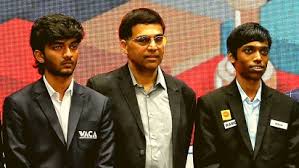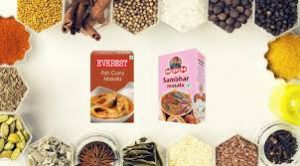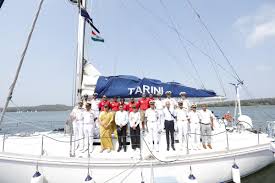Today’s Current Affairs: 24th April 2024 for UPSC IAS exams, State PSC exams, SSC CGL, State SSC, RRB, Railways, Banking Exam & IBPS, etc
Table of Contents
Biomarkers:

Screening for blood biomarkers has been proposed as a potential way to diagnose cancer at earlier stages of the disease.
- Biological Markers’ are a physical, chemical or biological characteristic that is present in the human body and measurable too.
- The WHO defines a biomarker as “any measurement reflecting an interaction between a biological system and a potential hazard, which may be chemical, physical or biological.
- The measured response may be functional and physiological, biochemical at the cellular level or a molecular interaction”.
- Experts also call them molecular markers and signature molecules.
- They are indispensable in diagnosing disease, prescribing the right medication, right dosage, and even while designing new drugs.
- Biomarkers include biomolecules like carbohydrates, proteins, lipids, genes, DNA, RNA, platelets, enzymes, hormones, etc.
- Classification of Biomarkers:
- Molecular– have biophysical properties, which allow their measurements in biological samples such as blood plasma, serum, cerebrospinal fluid, bronchoalveolar lavage, biopsy, urinalysis, and faecal analysis
- Radiographic– obtained from imaging studies, for example, bone mineral density
- Histologic– reflect biochemical or molecular alteration in cells, tissues, or fluids; for example, the staging and grading of cancers
- Physiologic– measures of body processes, for example, blood pressure, pulse rate, and heart rate
Candidates Chess Tournament 2024:

India’s 17-year-old Grandmaster D Gukesh recently made history by winning the Candidates Chess Tournament in Toronto to become the youngest ever challenger to the world title.
- Candidates Chess Tournament is the final event in the World Championship cycle before the World Championship match itself.
- The International Chess Federation (FIDE) has organized the World Championship cycle since 1948 and the Candidates Tournament since 1950.
- Since 2013, the Candidates Tournament has occurred every two years. The number of players in the tournament varied over the years, between eight and fifteen players. Currently, it is an eight-player, double round-robin event (that is all-play-all with both colours).
- It is the second most important tournament in the World Championship cycle, as the winner of the Candidates Tournament plays the reigning world champion in the championship match.
- Multiple tournaments are part of the World Championship cycle, but the real point of all of them is to qualify for the Candidates Tournament.
Indelible Ink Used In Election:

With the first phase of voting for the 2024 Lok Sabha elections beginning on April 19, the classic symbol of Indian polls is visible everywhere – a left hand with only its index finger extended, marked by a purple-black indelible ink.
- Devised as a method to prevent a person from casting more than one vote, the indelible ink has been used for decades in India.
- It has also travelled to other parts of the world to help in conducting elections.
- The Section 61 of Representation of the People Act (RoPA) of 1951 mentions the ink. It states that rules may be made under the Act “for the marking with indelible ink of the thumb or any other finger of every elector who applies for a ballot paper or ballot papers for the purpose of voting at a polling station before delivery of such paper or papers to him.”
- Indelible ink contains silver nitrate.
- It is a colourless compound which becomes visible when exposed to ultraviolet light, including sunlight.
- The water-based ink also contains a solvent like alcohol to allow its faster drying.
- Silver nitrate is an inorganic compound with the chemical formula AgNO3.
- The higher silver nitrate’s concentration, say around 20 percent, the higher will be the ink’s quality, according to a report from the United Nations Development Programme.
- For up to 72 hours after application it can remain resistant to soap, liquids, home-cleansing, detergents, etc.
- The indelible ink was first manufactured at the ECI’s request by the government’s Council of Scientific & Industrial Research (CSIR).
- It was later patented by the National Research Development Corporation (NRDC), New Delhi.
- Mysore Paints & Varnish Ltd. has been licensed to manufacture the ink and has been in the business since 1962.
- Today, once a voter has her credentials checked at the polling booth, and before she casts her vote by pressing a button on the Electronic Voting Machine (EVM), the indelible ink is applied on her finger. This has been the case for decades, although the mode of voting has changed.
Ethylene oxide In Indian Spices:

Following red flags raised by food regulators in Hong Kong and Singapore regarding the presence of a cancer-causing ingredient in certain Indian spice products from some brands, the Indian government has ordered food commissioners to collect samples of spices from all manufacturing units in the country.
- The harmful substance, ethylene oxide, has been classified as a ‘Group 1 carcinogen’ by the International Agency for Research on Cancer.
- Ethylene oxide is banned for use in food items in India.
- Ethylene oxide, primarily used as a sterilizing agent and insecticide, poses health risks including irritation of the eyes, skin, nose, throat, and lungs, as well as potential long-term effects on the central nervous system and carcinogenic properties.
50 Years Of Chipko Movement:

The Chipko movement, which originated in the 1970s in the Himalayan villages of Reni and Mandal, marked its 50th anniversary recently.
- The Chipko movement was a non-violent protest that began in the Chamoli district of Uttarakhand (then Uttar Pradesh), India, in 1973.
- Led by environmental activists such as Sundarlal Bahuguna and Gaura Devi, among others, the movement aimed to prevent the felling of trees in the Himalayan region.
- The name “Chipko” comes from the Hindi word meaning “embrace,” as villagers hugged the trees to prevent their cutting.
- The original Chipko movement dates back to 1730 when Amrita Devi Bishnoi and over 300 others from the Bishnoi sect sacrificed their lives protesting the felling of Khejarli trees in Rajasthan.)
- Impact of Chipko Movement : Environmental Awareness and Conservation Raised awareness about deforestation and the importance of conserving forests.
INSV Tarini:

The Indian Naval Sailing Vessel INSV Tarini returned to her base port at Goa after a historic transoceanic expedition of nearly two months by two women officers of the Indian Navy.
- The journey included interactions with Mauritian officials and a training sortie with the Mauritius Coast Guard, strengthening ties between the two nations.
- This accomplishment signifies the Indian Navy’s dedication to gender equality and empowering women in maritime roles.
- The officers are now preparing for their next adventure – a global circumnavigation expedition called Sagar Parikrama-IV, scheduled for September 2024 aboard INSV Tarini.
- INSV Tarini is the second sailboat of the Indian Navy after INSV Mhedi.
- It is known for circumnavigating the globe with an all-women officer crew in the historic expedition titled ‘Navika Sagar Parikrama’ in 2017.
Patient Safety Rights Charter : WHO

The World Health Organization (WHO) launched a first-ever Patient Safety Rights Charter at the Global Ministerial Summit on Patient Safety.
- It is the first Charter to outline patients’ rights in the context of safety.
- It will help governments and hospitals in formulating the legislation, policies and guidelines needed to ensure patient safety.
- The charter outlines the core rights of all patients in the context of the safety of health care and seeks to assist governments and other stakeholders to ensure that the voices of patients are heard and their right to safe health care is protected.
- The Charter covers 10 patient safety rights crucial to mitigate risks and prevent unintentional harm, which includes the
- Timely, effective and appropriate care
- Safe health care processes and practices
- Qualified and competent health workers
- Safe medical products and their safe and rational use
- Safe and secure health care facilities
Star Campaigners:

Political parties are appointing ‘star campaigners’ for their campaign in the ongoing general elections.
- Star Campaigners in election is a famous person with a huge fan following chosen by a political party to contest or campaign during elections.
- The Representation of the People Act, 1951 (RP Act) provides for law relating to expenditure incurred by ‘leaders of a political party’.
- These ‘leaders of a political party’ are popularly known as ‘star campaigners’. These are usually the top leaders of the party but can include other celebrities as well.
- The RP Act provides that a recognised political party (National or State) can appoint a maximum of 40 star campaigners while a registered unrecognised political party can appoint up to 20.
- These names are to be communicated to the Election Commission (EC) and Chief Electoral Officer (CEO) of the States as applicable within seven days from the date of notification of such election.
- In case of a multi-phase election, a political party can submit separate list of star campaigners for different phases.
- If in any rally/meeting organised, the star campaigner seeks votes in the name of contesting candidate(s) or shares the dais with them, then the rally/meeting expense shall be apportioned to the election expenditure of such candidate(s).
- If the star campaigner incurs boarding/lodging expenses while campaigning for any candidate(s), it shall be included in the expenditure account of such candidate(s) irrespective of whether it is paid for by the candidate(s).
- If any candidate(s) travel with the star campaigner, then 50% of the travel expenditure of the star campaigner shall also be apportioned to such candidate(s).
- When a Prime Minister or a former Prime Minister is a star campaigner, the expenditure on security including on bullet-proof vehicles will be borne by the government.
- But if the Prime Minister is accompanied by another star campaigner, the candidate has to bear 50 per cent of expenditure on the security arrangements
National Service Scheme:

Trained National Service Scheme (NSS) volunteers from 153 NSS units will offer their services to differently abled people and senior citizens in Kozhikode district on the day of polls.
- National Service Scheme was launched during 1969, the birth centenary year of Mahatma Gandhi.
- It is a Central Sector Scheme of the Government of India.
- It provides an opportunity to the student youth of the 11th & 12th Class of schools at +2 Board level and student youth of Technical Institution, Graduate & Post Graduate at colleges and University level of India to take part in various Government led community service activities & programmes.
- The NSS symbol is based on the “Rath” wheel of the Konark Sun Temple situated in Odisha.
- The navy blue colour indicates the cosmos of which the NSS is a tiny part, ready to contribute its share for the welfare of the mankind.
- The Red colour in the badge indicates that the NSS volunteers are full of blood i.e. lively, active, energetic and full of high spirit.
- The giant wheels of the Sun Temple portray the cycle of creation, preservation and release and signify the movement in life across time and space.
- Motto: The motto of National Service Scheme is NOT ME BUT YOU
- Nodal Ministry: Ministry of Youth Affairs & Sports.
Rashtriya Arogya Nidhi Scheme:

The Delhi High Court said that the threshold income to claim benefit under the Rashtriya Arogya Nidhi (RAN) scheme was prima facie “extremely low”.
- Rashtriya Arogya Nidhi scheme was set up in 1997 and it is a central sector scheme. It provides one-time financial assistance to poor patients living below State/UT wise threshold poverty line and suffering from life threatening diseases relating to heart, kidney, liver, cancer, etc. for treatment at any of Super Specialty Government hospitals/institutes.
- The Umbrella Scheme of RAN has three components as under:
- Rashtriya Arogya Nidhi (RAN) – Financial assistance for treatment of life-threatening diseases relating to heart, kidney, liver, etc. at Government hospitals/institutes having Super Specialty facilities; (Maximum financial assistance is 15 lakhs)
- Health Minister’s Cancer Patient Fund (HMCPF) – Financial assistance for treatment of cancer at Regional Cancer Centres (RCCs)/ Tertiary Care Cancer Centres (TCCCs) and State Cancer Institutes (SCIs); (Maximum financial assistance is Rs. 15 lakhs)
- Financial assistance for poor patients suffering from rare diseases – for specified rare diseases for treatment at Government hospitals/institutes having Super Specialty facilities; (Maximum financial assistance is Rs. 20 lakhs)
Rights Of Persons With Disabilities Act, 2016:

The Supreme Court recently lamented that the implementation of the Rights of Persons with Disabilities Act, 2016 (RPWD Act) remains dismal across India.
- Rights of Persons with Disabilities Act, 2016 (RPwD Act) replaced the Persons with Disabilities (Equal Opportunities, Protection of Rights, and Full Participation) Act, 1995.
- Its objective is to ensure that all persons with disabilities can lead their lives with dignity, without discrimination and with equal opportunities.
- It incorporates the rights of persons with disabilities covered under the United Nations Convention on the Rights of Persons with Disabilities (UNCRPD), to which India is a signatory.
- Under the Act, disability has been defined as an evolving and dynamic concept. The types of disabilities have been increased from existing 7 to 21, and the Central Government will have the power to add more types of disabilities.
- The types of disabilities include Leprosy Cured Person, Cerebral Palsy, Acid Attack Victims, Blindness, Deaf, Specific Learning Disabilities, Autism Spectrum Disorder, Parkinson’s Disease, Haemophilia, etc.
- Persons with “benchmark disabilities” are defined as those certified to have at least 40 percent of the disabilities specified.
- Responsibility has been cast upon the appropriate governments to take effective measures to ensure that persons with disabilities (PwDs) enjoy their rights equally with others.
- Additional benefits have been provided for persons with benchmark disabilities and those with high support needs.
- Every child with a benchmark disability between the age group of 6 and 18 years shall have the right to free education.
- 5% reservation in seats in Government and Government aided higher educational institutions for persons with benchmark disabilities.
- Stress has been given to ensure accessibility in public buildings (both Government and private) in a prescribed time-frame.
- 4% reservation in Government jobs for certain persons or class of persons with benchmark disability.
- The Act provides for the grant of guardianship by the District Court or any authority designated by the State Government under which there will be joint decision–making between the guardian and the PwDs.
- Broad-based Central and State Advisory Boards on Disability to be set up as policy-making bodies.
- It provides for the strengthening of the Office of Chief Commissioner of Persons with Disabilities and the State Commissioners of Disabilities, which will act as regulatory bodies and Grievance Redressal agencies and also monitor the implementation of the Act.
- These Offices will be assisted by an Advisory Committee comprising of experts in various disabilities.




